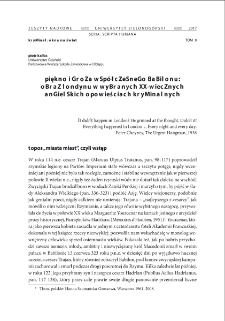Repozytorium Uniwersytetu Zielonogórskiego udostępnia 9 312 obiektów cyfrowych
Obiekt
Tytuł: Piękno i groza współczesnego Babilonu: obraz Londynu w wybranych XX-wiecznych angielskich opowieściach kryminalnych = The beauty and the horror of modern Babylon: the image of London in selected 20th-century English detective stories
Współtwórca:
Ruszczyńska, Marta - red. ; Kulczycka, Dorota - red. nauk. ; Brylla, Wolfgang J. - red. ; Gazdecka, Elżbieta - red.
Tytuł publikacji grupowej:
Streszczenie:
Celem niniejszego eseju jest przyjrzenie się metaforze "współczesnego Babilonu", w wieku XIX i w pierwszej połowie wieku XX bardzo rozpowszechnionej zarówno w ówczesnej literaturze, jak i publicystyce. Co prawda kilka innych miast również nazywano wówczas w ten sposób (np. Wiedeń i Paryż, a nieco poźniej także Berlin), ale to właśnie Londyn był tak określany najczęściej. ; Co nam ta metafora mówi o mieście nad Tamizą u progu epoki nowoczesnej? Czego nowego dowiadujemy się poprzez nadanie Londynowi miana "współczesnego Babilonu"? Co możemy z popularności tej metafory wywnioskować? By na te i podobne pytania odpowiedzieć, musimy zacząć od postawienia jeszcze jednego: z czym konkretnie kojarzył się Babilon XIX-wiecznym Europejczykom?
Abstract:
The aim of the present essay is to study the origins and variegated meanings of the striking metaphor LONDON IS THE MODERN BABYLON, widespread since at least the early 19th century. What did the notion of "Babylon" actually mean to the Victorians? What made London its pre-eminent modern incarnation? What aspects of the British capital made people compare it to the legendary ancient metropolis? ; Secondly, late-19th century London was also the birthplace of the detective story (and the detective novel). What image of the city do we find in the pages of the many crime stories set in London? What role does the place itself (both the real city and the fictional world of the stories) play in the narratives? ; These and other, similar questions are discussed on the basis of five successful literary texts representing various subgenres of the detective (crime) story: one of G.K. Chesterton`s famous Father Brown tales, "The Blue Cross" (1910), the "Golden Age" novel by Mavis Doris Hay, "Murder Underground" (1935), John Fowler` postmodern novella, "The Enigma" (from the collection entitled "Ebony Tower", 1974), and two novels by living authors: Peter Ackroyd`s masterpiece of "literary crime", "Hawksmoor" (1985) and Nigel Williams` hilarious parody of the genre, "The Wimbledon Poisoner", 1990. ; The conclusion seems to be that London, the legendary city, the city of mysteries and of magic, both the horror and the wonder of the age, does deserve the appellation of "modern Babylon" perhaps more than any other, modern, Western city.
Wydawca:
Zielona Góra: Oficyna Wydawnicza Uniwersytetu Zielonogórskiego
Format:
Identyfikator zasobu:
Strony:
Źródło:
Zeszyty Naukowe Uniwersytetu Zielonogórskiego: Seria Scripta Humana, tom 9
Jezyk:
Prawa do dysponowania publikacją:
Biblioteka Uniwersytetu Zielonogórskiego
Kolekcje, do których przypisany jest obiekt:
- Repozytorium > Jednostki organizacyjne > Wydział Humanistyczny
- Repozytorium > Typy utworów > Rozdziały w książkach
- Repozytorium > Czasopisma naukowe i serie wydawnicze UZ > Zeszyty Naukowe Uniwersytetu Zielonogórskiego: Seria Scripta Humana
Data ostatniej modyfikacji:
19 lut 2024
Data dodania obiektu:
8 lut 2024
Liczba wyświetleń treści obiektu:
157
Wszystkie dostępne wersje tego obiektu:
https://zbc.uz.zgora.pl/repozytorium/publication/87178
Wyświetl opis w formacie RDF:
Wyświetl opis w formacie OAI-PMH:
Obiekty Podobne
Kallas, Piotr Kulczycka, Dorota - red. nauk. Ruszczyńska, Marta - red. Brylla, Wolfgang J. - red. Gazdecka, Elżbieta - red.
Popielska-Grzybowska, Joanna Kulczycka, Dorota - red. nauk. Ruszczyńska, Marta - red. Brylla, Wolfgang J. - red. Gazdecka, Elżbieta - red.
Wiatrzyk-Iwaniec, Marta Kulczycka, Dorota - red. nauk. Ruszczyńska, Marta - red. Brylla, Wolfgang J. - red. Gazdecka, Elżbieta - red.
Tosik, Magdalena Kulczycka, Dorota - red. nauk. Ruszczyńska, Marta - red. Brylla, Wolfgang J. - red. Gazdecka, Elżbieta - red.
Nagy, László Kálmán Ruszczyńska, Marta - red. Kulczycka, Dorota - red. nauk. Brylla, Wolfgang J. - red. Gazdecka, Elżbieta - red.
Gazdecka, Elżbieta Kulczycka, Dorota - red. nauk. Ruszczyńska, Marta - red. Brylla, Wolfgang J. - red. Gazdecka, Elżbieta - red.
Samsel-Chojnacka, Monika Kulczycka, Dorota - red. nauk. Ruszczyńska, Marta - red. Brylla, Wolfgang J. - red. Gazdecka, Elżbieta - red.
Dajnowski, Maciej Kulczycka, Dorota - red. nauk. Ruszczyńska, Marta - red. Brylla, Wolfgang J. - red. Gazdecka, Elżbieta - red.

